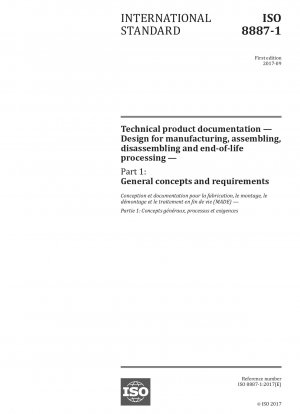ISO 8887-1:2017
Technical product documentation - Design for manufacturing, assembling, disassembling and end-of-life processing - Part 1: General concepts and requirements
- Standard No.
- ISO 8887-1:2017
- Release Date
- 2017
- Published By
- International Organization for Standardization (ISO)
- Latest
- ISO 8887-1:2017
- Scope
- This document specifies the requirements for the preparation, content and structure of technical product documentation (TPD) of design output for the cycles of manufacturing, assembling, disassembling and end-of-life processing of products. It describes the TPD needed at the critical stages of a design process. It identifies and describes methods and conventions appropriate to the preparation of documentation, in whatever form, necessary to realize a design including the application to multiple life cycles. It extends beyond specification for the manufacturing and assembling of products to incorporate guidance on the ultimate reusing, recovering, recycling and disposing of the components and materials used.
ISO 8887-1:2017 Referenced Document
- ISO 10209:2012 Technical product documentation - Vocabulary - Terms relating to technical drawings, product definition and related documentation
- ISO 11442:2006 Technical product documentation - Document management
- ISO 14040:2006 Environmental management - Life cycle assessment - Principles and framework
- ISO 14041:1998 Environmental management - Life cycle assessment - Goal and scope definition and inventory analysis
- ISO 15226:1999 Technical product documentation - Life cycle model and allocation of documents
- ISO/TR 14062:2002 Environmental management - Integrating environmental aspects into product design and development
ISO 8887-1:2017 history
- 2017 ISO 8887-1:2017 Technical product documentation - Design for manufacturing, assembling, disassembling and end-of-life processing - Part 1: General concepts and requirements
